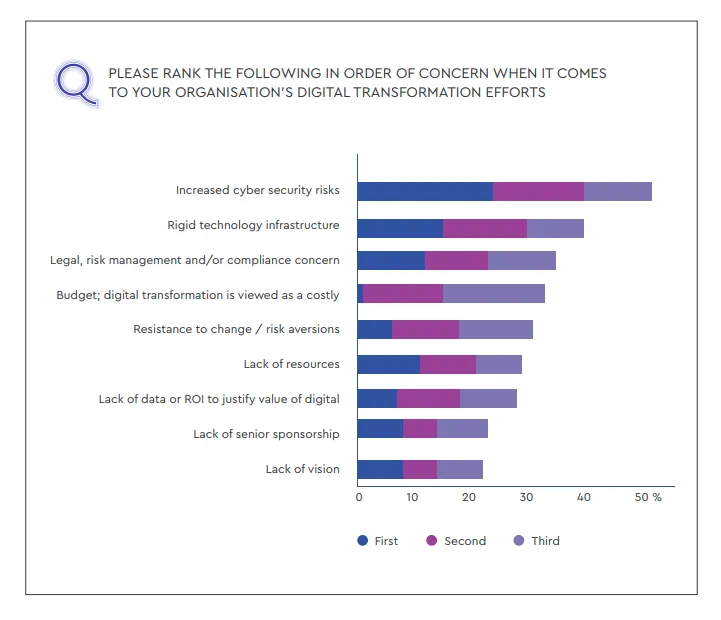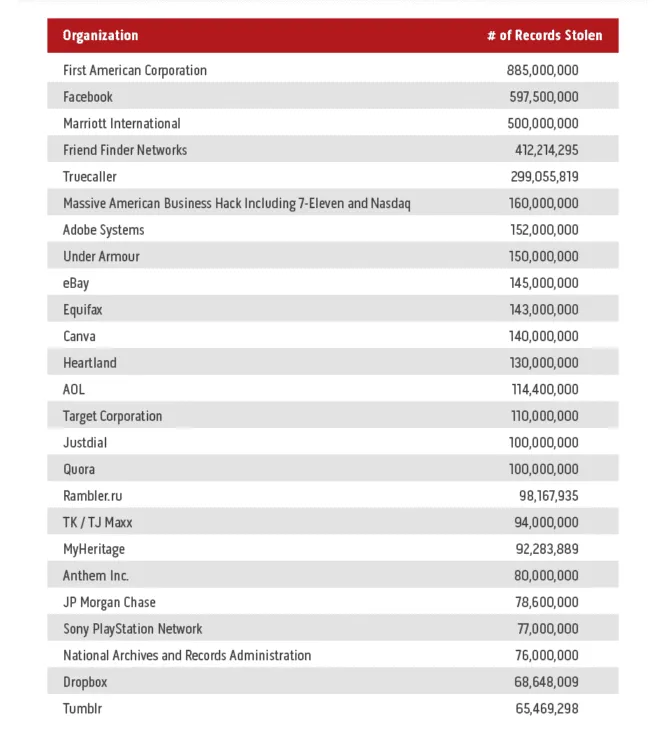Major IT Challenges CIOs Will Face Over the Next 5 Years

The role of the modern CIO has been in a state of flux in recent years. Increasingly, it has become a balancing act between managing traditional IT operations and driving strategic initiatives, with transformational change high on the agenda.
As we head into the 2020s, one thing is certain: This is a time of enormous change for enterprises as a whole. Digital disruption and increasing customer expectations are the driving force behind much of it and forward-thinking companies (Microsoft, Nike, and Target to name a few) are embracing the opportunity. Forty-four percent of organizations anticipate a fundamental change in their business model or product/service offering in the next three years.
But despite the exciting opportunities and innovative technologies this decade will bring, there will still be many hurdles along the way. In this article, we take a look at six of the top IT challenges that you, as a CIO, will face over the next five years. We’ll also give you some actionable advice on how to address them!
Table of Contents
6 IT Challenges and Solutions: Preparing the Modern-Day CIO for the Future
1. Managing Data Protection
Effective data governance continues to be a significant source of concern. With the introduction of the EU’s General Data Protection Regulation (GDPR) in 2018, CIOs are no stranger to the importance of meticulous data management. However, ensuring ongoing compliance plus a plethora of new regulations on the horizon means that organizations can’t afford to rest on their laurels.
Penalties for non-compliance are hefty. Google, British Airways, and Marriott have already fallen foul of GDPR with record fines in excess of $100 million each and unmeasured reputational damage.
In the US, the California Consumer Privacy Act (CCPA) went into effect at the start of this year and a number of other states are expected to follow suit. Organizations will thus need to rewrite their existing policies to comply with the new regulations, which, of course, will prove challenging.
Overcoming the Challenge
The only way you can guarantee compliance on a global scale will be to set your data safety standards at the level of the most restrictive regulation.
On a more general basis, you should:
- Work to uphold the principle of transparency by updating digital policies and privacy notifications to reflect changes in the organization’s procedures.
- Keep a tight grip on data flows by developing a thorough understanding of how information is stored, deployed, and accessed, including the security measures of vendors.
- Consider taking extra steps to safeguard data, such as pseudonymization. You can rely on secure Windows VPN to protect your network, especially if you have a BYOD policy in place.
2. Digital Transformation Success
Whether companies are leading from the front or simply trying to avoid being left behind by competitors, digital transformation continues to be a hot topic in the C-Suite.
A survey by Nominet reveals that 93% of CIOs and CTOs believe that “their organization was either currently engaged in, or planning to engage in, a digital transformation program,” with only 6% of businesses claiming to have completed their transformation.
Although there is some discussion on whether digital transformation can ever really be considered complete, there are also indications that many organizations are struggling. According to new figures by McKinsey, there is a 45% chance that the average digital transformation project will deliver less profit than expected.
Overcoming the Challenge
To avoid these struggles, you can adopt certain transformation practices that significantly increase the odds of success:
- Focus on setting clear priorities that are directly linked to measurable business outcomes.
- Invest in highly talented people, particularly specialized leaders and those with strong digital and analytics skills.
- Ensure that people at all levels feel empowered.
- Adopt agile practices and update your digital strategies frequently.
- Devote time and money to your digital transformation efforts.

Research conducted by Nominet Cyber Security based on answers from CISOs, CTOs, and CIOs, across UK and US enterprises.
3. Bridging the (IT) Skills Gap
A side effect of mass digital transformation has been a failure in the supply of talent to keep up with demand, and the problem looks set to continue. Research by Barclaycard has shown that eight in 10 CIOs are worried about recruiting and upskilling tech staff to ensure they have the right mix of tech skills available within the organization.
KPMG paints an equally bleak picture, confirming that skills shortages are at their highest level since 2008, adding that “these shortages can’t fail to act as a bottleneck to growth”. The driving force behind the shortages is an investment in technology, such as AI, data analytics, and cybersecurity.
In an attempt to address this issue, some organizations are turning to contract workers to bridge the gap, but this strategy in itself presents new IT challenges, including personal data security and protecting intellectual property.
Overcoming the Challenge
Fortunately, there are a variety of short-term and longer-term strategies available to address skills shortages:
- Look beyond traditional sources of talent like IT graduates. You may find the skills you need in self-taught programmers, hackathons, and coding boot camps.
- Provide in-house digital skills training to develop the required capabilities. This can also create a source of competitive advantage. Cultivate talent through development programs. Quickly develop the skills of graduates and other new employees to meet the needs of the organization.
- Retain existing talent by providing continuous learning opportunities as well as allowing employees to work on stimulating projects that enhance job satisfaction.
Here, implementing Userlane’s Digital Adoption Platform, for example, would be highly advantageous. With Userlane’s DAP, employees can learn how to navigate any new or existing software with onscreen interactive guidance, anytime and anywhere.
And, most importantly, Userlane provides constant and contextual on-demand performance support, meaning that training is continuous. Employees never have to leave an application to consult other learning materials as everything happens in-app in real-time, thus boosting knowledge retention and turning employees into digital natives.
With Userlane, both new and existing employees will immediately have the skills necessary to navigate any software you will introduce in your organization over the coming years, saving you precious time and increasing productivity without delay.

4. Aligning Culture With Strategy
Transformation and the adoption of new technologies cannot take place in a vacuum. To successfully maximize the impact of new initiatives, the organization’s culture must be aligned with its strategy – and the task of driving this change is increasingly falling to you, the Chief Information Officer.
According to research by Gartner, by 2021, CIOs will be as responsible for changing the organization’s culture as the Chief Human Resources Officer is today. And with 46% of CIOs highlighting culture as the biggest barrier to change, it’s a fundamental key to success.
Overcoming the Challenge
Fostering cultural change can be challenging. CIOs should work in collaboration with HR to make technology choices and design processes in a way that supports the creation of the intended organizational culture. You can try to break down barriers to change by creating a small, successful team and using it to highlight achievements and quick wins. You can also encourage employees to own and champion their ideas.
5. Preparing for Emerging Technologies
Emerging technologies have the potential to transform the organization, but with so many being hailed as the ‘next big thing’, it’s difficult to know what to invest in and what to discount as hype. Adding to this, emerging technologies also pose a problem in training and specialist skill requirements, which may not be easy to come by.
Cloud computing is now well-established – a survey by KPMG shows that over three-quarters of respondents have now invested in this area. In the near term, the internet of things (IoT), robotic process automation, and artificial intelligence (AI) are expected to be the big winners. But within the next five years, you should also pay attention to virtual reality, blockchain, and quantum computing.
Gartner predicts that 20% of organizations will be budgeting for quantum computing projects by 2023 and adds that “CIOs need to start thinking about what value blockchain can add to their organization and how to tackle the challenges over the next five years.”
Overcoming the Challenge
You should look for potential opportunities from each of the emerging technologies and be ready to collaborate with data scientists and research scientists to help the business integrate them.
Other CIOs and IT professionals can be a great source of information so leverage the power of your network. Ask about what’s working for them or what isn’t delivering expected results.
And finally, although it’s easier said than done, set aside time for research. Set up Google alerts for each of the technologies you are interested in, observe what’s making headlines, and look for insights.
6. Never-Seen-Before Security Threats
Rapid advances in technology might be transforming the way we live and do business, but they are also introducing new and more complex security threats than ever before.
A recent study by cybersecurity firm Kastle Systems shows that over the last decade, there’s been a steady increase in data breaches and hacks. As many as 50% of the breaches were achieved with malware, although straightforward poor security was also responsible for a significant portion.
While next-generation, AI-driven cyberattacks haven’t featured heavily to date, you can expect this to change over the next five years. According to a report by Forrester, “mainstream AI-powered hacking is just a matter of time”. The means that using AI offensively already exists, from open-source AI research projects and sophisticated malware to the ruthless, financially-motivated criminals inclined to use them.
Overcoming the Challenge
In addition to addressing known vulnerabilities in the security of the organization and that of its partners, you should look ahead to invest in new technology. As AI becomes an integral part of the cybercriminal’s armory, your most effective defense will be AI itself. Adopting it and integrating it into the organization’s security infrastructure early enough will be critical.

Facing IT Challenges Head-On: The CIO as the Torchbearer of Success
Technology is advancing at a breakneck pace and continues to disrupt business-as-usual in the enterprise world. Some organizations are seizing the opportunity to pivot and become more agile while others are being forced to transform in an effort to keep up.
Wherever an organization falls along this spectrum, there are major IT challenges in the coming five years that will be common to all CIOs.
In addition to navigating pressing concerns like data protection and bridging the skills gap, you also need one eye on the horizon to be successful. While we might not see the widespread adoption of emerging technologies like quantum computing any time soon, others like AI are well on their way to becoming established and will accelerate the pace of change.
Apart from the IT challenges mentioned above, there is another huge one that enterprises face, namely: Introducing software successfully. Employees need to adopt software if organizations are to achieve full digital adoption. For more insight into this topic and how you can have a successful software rollout with little resistance to change from employees, download our whitepaper!

